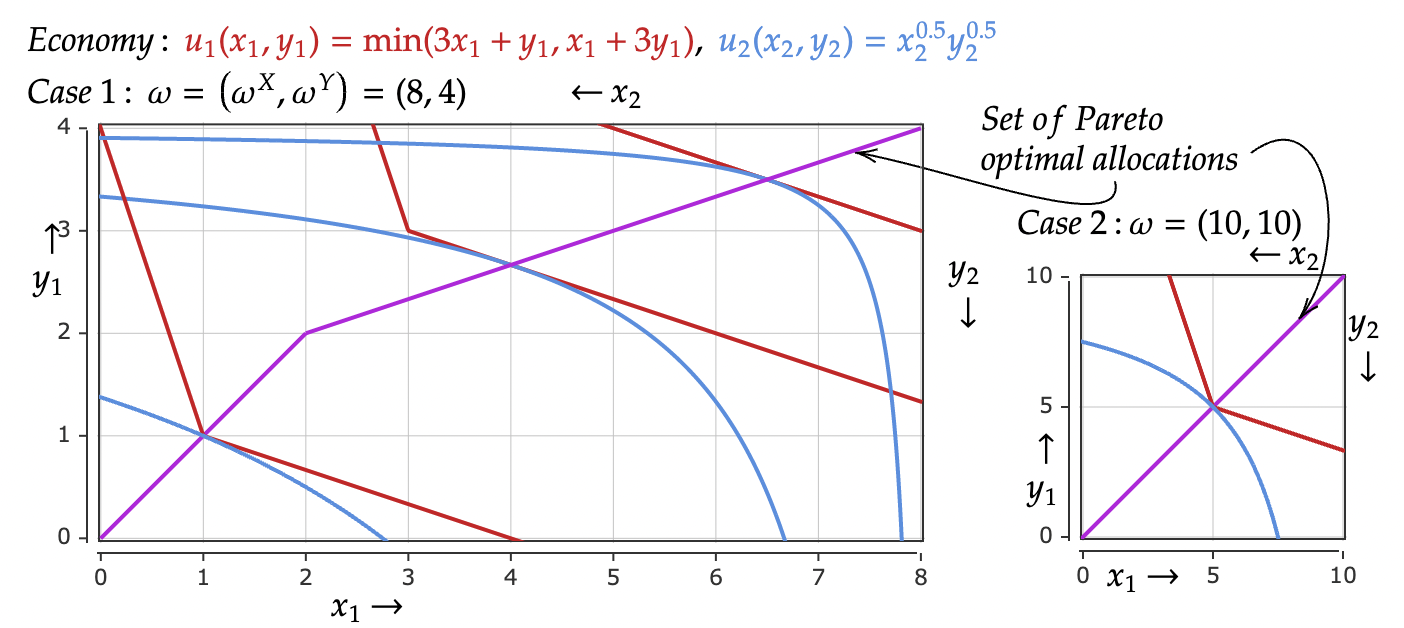Suppose a pure exchange economy where agents’ ($A$ and $B$) preferences are given by the following utility functions:
$u_A = \min(3x+y,x+3y)$
$u_B = x^\frac{1}{2} y^\frac{1}{2}$
Find the contract curve.
The arguments of the min operator are equal $\iff x_A = y_A$
Now I split the Edgeworth box into $3$ regions.
- $x_A < y_A$
Here both utilities are differentiable and one of them is Cobb-Douglas, so I use $MRS$
In this region, $u_A = 3x + y$ as this is the smallest argument of the $\min$ in this region.
$MRS_A = MRS_B \iff 3 = \frac{y_B}{x_B}$
Therefore, the segment of the contract curve in this region is
$y_B = 3 x_B$
- $x_A > y_A$
Similarly as above, in this region, $u_A = x + 3y$, and
$MRS_A = MRS_B \iff \frac{1}{3} = \frac{y_B}{x_B}$
Therefore, the segment of the contract curve in this region is
$y_B = \frac{1}{3} x_B$
- $x_A = y_A$
This is the line where $u_A$ is not differentiable and it’s the set of kinks of $A$’s indifference curves.
Let $(\alpha,\beta)$ be the total endowments of $(x,y)$, respectively.
Since $x_A = y_A$,
$MRS_B = \frac{y_B}{x_B} = \frac{\beta - y_A}{\alpha - x_A} = \frac{\beta - x_A}{\alpha - x_A} \in (\frac{1}{3},3) $
$\iff \frac{1}{3} \alpha - \frac{1}{3} x_A < \beta - x_A < 3 \alpha - 3 x_A $
$\iff \frac{1}{3} \alpha + \frac{2}{3} x_A < \beta < 3 \alpha - 2 x_A$
Graphically we can see that if the slope of the Cobb-Douglas IC’s tangent is in the set $(\frac{1}{3},3)$, then this tangent is below $A$’s IC and hence $B$’s IC would intersect with $A$’s IC at exactly one point, namely, the kink.
We can see in the graph below, that $MRS_B \in (\frac{1}{3},3)$ implies that if we deviate from the kink along $A$’s IC, we would end up in a worse Cobb-Douglas IC.
This would imply that the kink is a Pareto efficient point.
If $MRS_B$ happened to be either of the endpoints of the interval, then the Cobb-Douglas IC’s tangent would be one of $A$’s IC line segments, and $B$’s IC would still intersect $A$’s IC exactly at the kink, implying the kink is still a Pareto efficient point.
On the other hand, if $MRS_B < \frac{1}{3}$ or $MRS_B > 3$, then the Cobb-Douglas IC’s tangent goes above $A$’s IC in some region, implying both ICs now intersect at a second point.
Taking any non-trivial convex combination of those two points would yield a point on the same IC curve for $A$ that lies on a strictly better Cobb-Douglas IC, as seen in the graph below.
This would imply that the kink is not a Pareto efficient point.
————————————————————————
I also found conditions for both regions where $x_A \neq y_A$ in terms of the total endowments $(\alpha,\beta)$.
Note $MRS_B = 1 \in (\frac{1}{3},3)$ along $x_A = y_A$ for symmetric endowments $(\alpha = \beta)$.
- For $x_A < y_A$
Rewriting the contract curve in terms of agent $A$,
$y_A = 3 x_A + \beta - 3 \alpha$
I got $x_A < y_A \iff x_A > \frac{3}{2} \alpha - \frac{1}{2} \beta$.
Note this inequality is impossible for symmetric endowments $(\alpha = \beta)$ as it would become $x_A > \alpha$, i.e. agent $A$ consuming more $x$ than the total endowment.
- $x_A > y_A$
Rewriting the contract curve in terms of agent $A$,
$y_A = \frac{1}{3} x_A + \beta - \frac{1}{3} \alpha$
I got $x_A > y_A \iff x_A > \frac{3}{2} \beta - \frac{1}{2} \alpha$.
Note this inequality is impossible for symmetric endowments $(\alpha = \beta)$ as it would become $x_A > \alpha$, i.e. agent $A$ consuming more $x$ than the total endowment.
————————————————————————
By the notes above, I got that for symmetric endowments, the contract curve is simply $x_A = y_A$, which would be the line segment connecting both origins of the Edgeworth box.
However, I am having trouble visualizing all the conditions involving the endowments at the same time (for non-symmetric endowments), to get a final answer for the contract curve I can actually graph. I would appreciate any help on this part.



